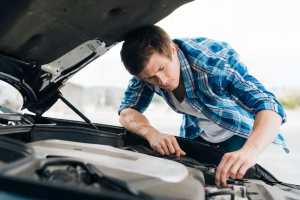Before heading out on a long-distance road trip, most drivers check their oil, tires, and brakes — but often overlook the radiator, one of the most critical parts of the engine’s cooling system. The radiator’s role is to dissipate heat generated by the engine, keeping the temperature within safe limits. If it fails on the highway, you could face overheating, breakdowns, or even permanent engine damage.
Preparing your radiator properly before a long journey ensures that your cooling system operates efficiently and prevents unexpected issues on the road. In this article, we’ll cover everything you need to know — from inspection and cleaning to coolant checks and leak testing.
Why Radiator Preparation Matters Before Long Trips

During long drives, especially in warm weather or mountainous terrain, your engine works harder for extended periods. The radiator must maintain optimal cooling efficiency to prevent heat buildup.
Neglecting radiator maintenance can lead to:
-
Engine overheating and breakdown.
-
Coolant leaks and corrosion.
-
Reduced fuel economy due to inefficient cooling.
-
Permanent engine damage from thermal stress.
A quick inspection before departure can save you hours of delay — and costly repairs later.
Step-by-Step Guide to Preparing Your Radiator
Step 1: Inspect the Radiator Externally
Start by visually examining the radiator and surrounding components:
-
Check for visible leaks — look for green, orange, or pink stains under the vehicle.
-
Inspect radiator fins — they should be clean, straight, and free from mud or bugs.
-
Check the hoses — squeeze them gently; they should be firm but flexible. Cracked or brittle hoses must be replaced.
-
Look at hose clamps and fittings — ensure they are tight and corrosion-free.
| Component | What to Check | Possible Issue | Action Required |
|---|---|---|---|
| Radiator fins | Dirt, debris, or bent metal | Reduced airflow | Clean gently with water or air |
| Hoses | Cracks or bulges | Coolant leak risk | Replace if damaged |
| Radiator cap | Loose or rusted | Pressure loss | Replace with OEM-rated cap |
| Coolant level | Below minimum mark | Insufficient cooling | Top up or flush system |
Step 2: Check Coolant Level and Condition
Coolant (antifreeze) prevents overheating in summer and freezing in winter.
-
Open the coolant reservoir (when engine is cold).
-
The level should be between “MIN” and “MAX.”
-
Check color and clarity: bright green, pink, or orange coolant is normal; brown or cloudy fluid indicates contamination or rust.
If coolant appears dirty or is over 2 years old, a flush and refill is recommended. Use the coolant type specified in your owner’s manual — mixing incompatible types can cause deposits and blockages.
Step 3: Flush the Radiator (if Needed)
A radiator flush removes scale, rust, and old fluid residues that restrict coolant flow.
When to flush the system:
-
Every 2 years or 40,000–60,000 km (depending on manufacturer).
-
If you see rust-colored coolant or reduced cooling performance.
Flushing steps:
-
Drain old coolant from the radiator drain plug.
-
Refill with radiator flush solution mixed with water.
-
Run engine for 10–15 minutes to circulate the cleaner.
-
Drain and rinse with clean water until it runs clear.
-
Refill with fresh coolant mixture (usually 50:50 antifreeze and distilled water).
Step 4: Inspect the Radiator Cap and Pressure
The radiator cap maintains system pressure to prevent coolant from boiling. A worn cap can lead to overheating or leaks.
Check the following:
-
Rubber seal — no cracks or hardening.
-
Pressure rating — matches your vehicle’s specification.
-
Spring action — should be firm and responsive.
| Symptom | Possible Issue | Solution |
|---|---|---|
| Coolant loss without visible leaks | Faulty radiator cap | Replace with correct rated cap |
| Overheating in traffic | Low system pressure | Test or replace cap |
| Bubbling in overflow tank | Cap not sealing properly | Clean or change immediately |
Step 5: Clean the Radiator Fins
Dirt, insects, and road grime can block airflow through the fins, reducing cooling efficiency.
To clean safely:
-
Let the engine cool completely.
-
Use low-pressure water (not a pressure washer) to rinse from back to front.
-
Gently brush with a soft-bristle brush if needed.
-
Straighten bent fins using a fin comb.
Avoid aggressive cleaning tools or chemicals — the fins are delicate and easily damaged.
Step 6: Check for Leaks and Pressure-Test the System
Even a small leak can escalate on a long trip. Perform a pressure test to confirm your system is sealed.
How to test:
-
Use a cooling system pressure tester (available at most auto shops).
-
Attach it to the radiator neck or coolant reservoir.
-
Pump to the cap’s rated pressure and monitor the gauge.
If pressure drops steadily, inspect for external leaks around hoses, the water pump, and the radiator core.
Step 7: Confirm Fan and Thermostat Operation
Even with a perfect radiator, the cooling system depends on proper fan and thermostat performance.
-
Run the engine and ensure the fan engages at the correct temperature.
-
Thermostat check: If the engine warms up too slowly or overheats quickly, the thermostat may be stuck open or closed.
Replacing these components before a long trip can prevent mid-journey failures.
Preventive Maintenance Schedule
| Maintenance Task | Frequency | Benefit |
|---|---|---|
| Coolant level check | Monthly | Prevents overheating |
| Coolant replacement | Every 2 years | Removes corrosion buildup |
| Hose inspection | Every 6 months | Avoids leaks and bursts |
| Radiator cleaning | Annually | Improves airflow |
| Pressure test | Before long trips | Detects hidden leaks |
Emergency Radiator Tips for Road Trips
Even with proper preparation, unexpected situations can occur. Keep these essentials in your trunk:
-
1–2 liters of premixed coolant.
-
Distilled water (for emergency top-ups).
-
Radiator stop-leak additive (temporary fix).
-
Gloves and safety goggles.
-
Basic tool kit (screwdrivers, pliers, wrench).
If the engine starts overheating:
-
Pull over and turn off the engine immediately.
-
Wait 15–20 minutes before opening the hood.
-
Never remove the radiator cap while hot.
-
Check coolant level once cooled and refill if necessary.
Common Mistakes to Avoid
| Mistake | Result | Prevention |
|---|---|---|
| Opening radiator when hot | Severe burns | Always cool engine first |
| Mixing coolant types | Corrosion and sludge | Use recommended type only |
| Overfilling coolant | Pressure buildup | Fill to “MAX” line only |
| Ignoring small leaks | Major breakdowns later | Fix immediately |
| Skipping radiator flush | Reduced cooling efficiency | Follow maintenance schedule |
When to Replace Your Radiator
Even a well-maintained radiator has a limited lifespan — typically 8–10 years depending on usage. You should consider replacing it if:
-
There are multiple pinhole leaks or corrosion spots.
-
The core fins are brittle or falling apart.
-
The cooling performance remains poor despite flushing.
For reliable, long-lasting components, Buy Radiator & Components online. You’ll find radiators, hoses, caps, and related parts compatible with your car, ensuring dependable cooling for every road trip.
Final Checklist Before Your Trip

Before hitting the road, make sure you’ve completed the following:
Coolant at proper level and in good condition.
Radiator and hoses inspected for leaks.
Cap tested or replaced.
Fan and thermostat operational.
Radiator fins cleaned and unobstructed.
Spare coolant and basic tools packed.
Conclusion
Your radiator is your engine’s first line of defense against overheating — especially on long journeys. A simple inspection and maintenance routine before you travel can make all the difference between a smooth ride and a costly breakdown.
By following the steps above, you’ll ensure your cooling system performs efficiently and your engine stays protected under all conditions.
For quality parts, upgrades, and replacements, Buy Radiator & Components online — and enjoy peace of mind knowing your vehicle is ready for any adventure ahead.